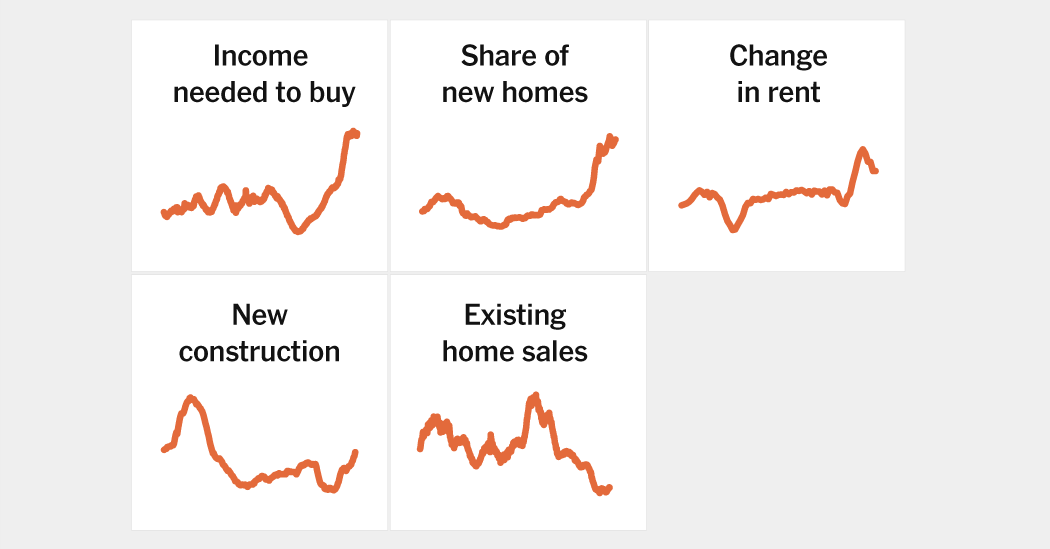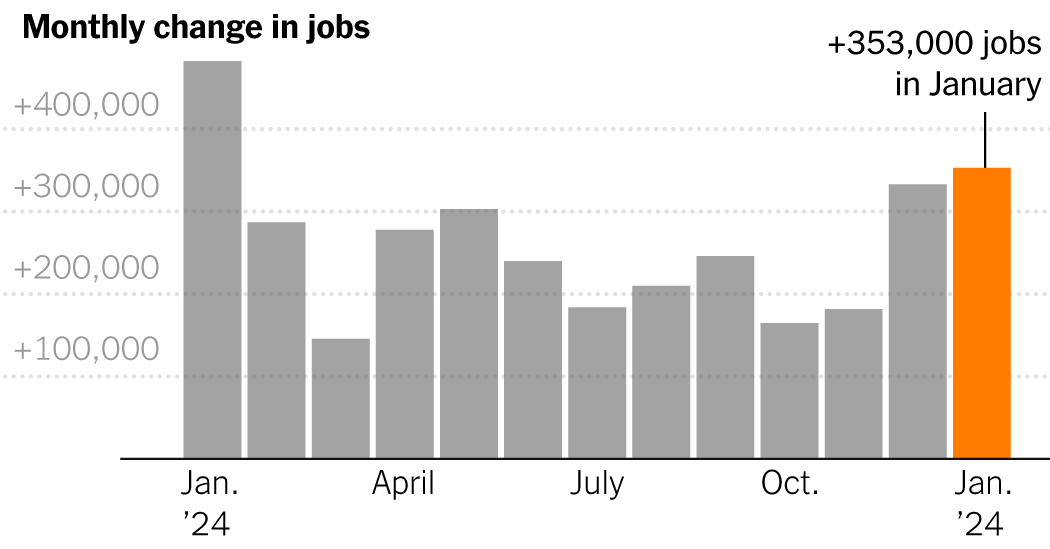June 22, 2024 | by Kaju

Residence costs have held up higher than anticipated amid excessive rates of interest. However that doesn’t imply the housing market is wholesome.
When the Federal Reserve started elevating rates of interest in 2022, most economists thought the housing market can be the primary to undergo the implications: Increased borrowing prices would make it costlier to purchase and to construct, resulting in diminished demand, much less development and decrease costs.
They had been proper — at first. Development slowed, however then picked up. Costs hiccuped, then resumed their upward march. Increased charges made properties tougher to afford, however People nonetheless wished to purchase them.
The result’s a housing market that’s totally different, and stranger, than the one described in economics textbooks. Components have proved surprisingly resilient. Different elements have seized up nearly utterly. And a few appear perched on a precipice, susceptible to tumbling if charges keep excessive too lengthy or the economic system weakens unexpectedly.
It’s also a market of stark divides. Individuals who locked in low charges earlier than 2022 have, generally, had their dwelling values soar however have been insulated from increased borrowing prices. Those that didn’t already personal, then again, have usually had to decide on between unaffordable rents and unaffordable dwelling costs.
However the state of affairs is nuanced. Owners in some elements of the nation face skyrocketing insurance coverage prices. Rents in some cities have moderated. Builders are discovering methods to make new properties inexpensive for first-time consumers.
Nobody indicator tells the total story. Reasonably, economists and business consultants say understanding the housing market requires taking a look at an array of information shedding gentle on totally different items of the puzzle.
1. It’s laborious to discover a dwelling to purchase.
The speedy rise in rates of interest pushed down demand for housing, by making it costlier to borrow. Nevertheless it additionally led to a giant drop in provide: Many homeowners are holding onto their properties longer than they might in any other case as a result of promoting would imply giving up their ultralow rates of interest.
This “charge lock” phenomenon has contributed to a extreme scarcity of properties on the market. It isn’t the one issue: Residence constructing lagged for years earlier than the pandemic, and retired child boomers have been selecting to remain of their properties reasonably than transferring to retirement communities or downsizing to condominiums as many housing consultants had anticipated.
Many economists argue that the shortage of provide has helped hold costs excessive, significantly in some markets, though they disagree in regards to the magnitude of the impact. What is for certain is that for anybody hoping to purchase, discovering a house has been extraordinarily tough.
2. Properties are unaffordable.
Residence costs, already excessive, soared in the course of the pandemic, rising greater than 40 % nationally from the tip of 2019 to mid-2021, in response to the S&P CoreLogic Case-Shiller worth index. They’ve risen extra slowly since then, however they haven’t fallen as many economists anticipated when the Fed began elevating rates of interest.
Rising rates of interest have put these costs even additional out of attain for a lot of consumers. Somebody shopping for a $300,000 home with a ten % down cost may anticipate to pay about $1,100 a month on a mortgage in late 2021, when rates of interest on a 30-year, fixed-rate mortgage had been about 3 %. As we speak, with charges at about 7 %, that very same home would value about $1,800 a month, a rise of about 60 % in month-to-month prices. (That doesn’t even consider the rising value of insurance coverage or different bills.)
Economists have alternative ways of measuring affordability, however all of them present just about the identical factor: Shopping for a home, significantly for first-time consumers, is additional out of attain than at any level in many years, or perhaps ever. One index, from Zillow, exhibits that the standard family shopping for the median dwelling with 10 % down may anticipate to spend greater than 40 % of their revenue on housing prices, effectively above the 30 % that monetary consultants suggest. And in lots of cities, corresponding to Denver, Austin and Nashville — by no means thoughts longtime outliers like New York and San Francisco — the numbers are a lot worse.
3. New properties are filling (a few of) the hole.
Maybe probably the most stunning growth within the housing market over the previous two years has been the resilience of new-home gross sales.
Builders usually wrestle when rates of interest rise, as a result of excessive borrowing prices drive away consumers whereas additionally making it costlier to construct.
However this time round, with so few present properties out there on the market, many consumers have been turning to new development. On the similar time, many huge builders had been capable of borrow when rates of interest had been low, and have been ready to make use of that monetary firepower to “purchase down” rates of interest for patrons — making their properties extra inexpensive with no need to chop costs.
In consequence, gross sales of recent properties have held comparatively regular at the same time as gross sales of present properties have plummeted. Builders have particularly sought to cater to first-time consumers by constructing smaller properties, a section of the market all of them however ignored for years.
It isn’t clear how lengthy the pattern can proceed, nevertheless. Many builders pulled again on exercise when charges first rose, leaving fewer new properties within the pipeline to return to market within the years forward. And if charges keep excessive, it might get tougher for builders to supply the monetary incentives they’ve used to draw first-time consumers. Non-public builders in Could broke floor on new properties on the slowest charge in practically 4 years, the Commerce Division stated on Thursday.
4. Rents are unaffordable, too.
Rents skyrocketed in a lot of the nation in the course of the pandemic, as People fled cities and sought area. Then they stored rising, because the sturdy labor market elevated demand.
Rising rents helped gas an apartment-building growth, which has introduced a flood of provide to the market, significantly in Southern cities like Austin and Atlanta. That has led rents to rise extra slowly and even to fall in some locations.
However that moderation has been gradual to work its means by means of the market. Many tenants are paying rents negotiated earlier within the housing cycle, and the brand new development has been concentrated within the luxurious market, which doesn’t do a lot to assist middle- or lower-income renters, no less than within the brief time period.
All of that has produced a rental affordability disaster that retains rising worse. A record share of renters are spending greater than 30 % of their revenue on housing, Harvard’s Joint Heart for Housing Research discovered just lately, and greater than 12 million households are spending greater than half their revenue on hire. Affordability is now not only a downside for the poor: The Harvard report discovered that hire is changing into a burden even amongst many households incomes greater than $75,000 a 12 months.
5. A shift could also be underway.
For a lot of the previous two years, the housing market — particularly for present properties — has been caught. Consumers can’t afford properties until both costs or rates of interest fall. Homeowners really feel little stress to promote, and aren’t wanting to turn into consumers.
What may break the logjam? One chance is decrease rates of interest, which may carry a flood of each consumers and sellers again to the market. However with inflation proving cussed, charge cuts don’t seem imminent.
One other chance is a extra gradual return to regular, as house owners resolve they’ll now not postpone long-delayed strikes and turn into extra keen to chop a deal, and as consumers resign themselves to increased charges.
There are indicators which may be starting to occur. Extra house owners are itemizing their properties on the market, and extra are reducing costs to draw consumers. Builders are ending extra new properties and not using a purchaser lined up. Actual property brokers are sharing anecdotes of empty open homes and houses that sit in the marketplace longer than anticipated.
Hardly anybody expects costs to break down. The millennial era is within the coronary heart of the home-buying years, which means demand for properties must be sturdy, and years of under-building imply the nation nonetheless has too few properties by most measures. And since most householders have loads of fairness, and lending requirements have been tight, there isn’t prone to be a wave of compelled gross sales as there was when the housing bubble burst practically 20 years in the past.
However that additionally signifies that the affordability disaster isn’t prone to resolve itself quickly. Decrease charges would assist, however it would take greater than that for homeownership to really feel achievable to many youthful People.
RELATED POSTS
View all


